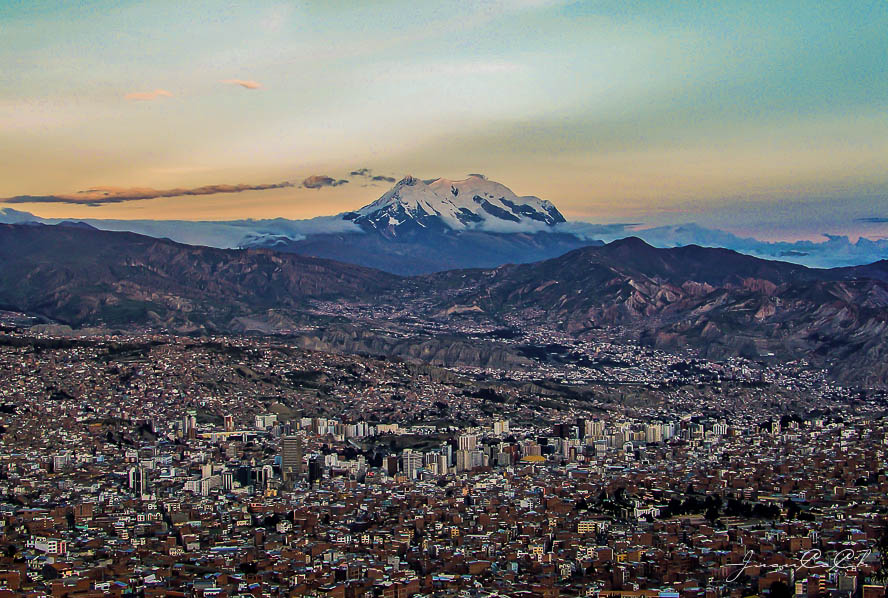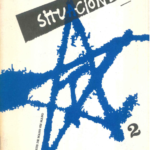Altitude Sickness. Notes on a Trip to Bolivia* (October, 2005) // Colectivo Situaciones

| 1. In its heterogeneity and permanent movement, Bolivia is at the same time the experience and the fracture of magma. It is there where faces, bodies, and languages tell stories that challenge those seeking to understand, accompany, and enjoy. Our trip, in February 2005, was a struggle between this attempt to understand and the difficulties of adaptation (of which altitude was not the least of obstacles). It is also a wager on the distinctive outlook opened by what took place in recent years in Argentina. And this dialogue between processes of de-institution-construction is vital for both.
2. To arrive in Bolivia is to be surprised at an atmosphere that concentrates an extreme tension between different elements, a polymorphous dynamic that today characterizes, in different ways, the syntaxis of the movements and struggles of a good portion of Latin America. To connect with Bolivia is part of a necessary and renovated literacy. It looks as though any image let itself be seen and read. Today the space referred to as “Latin American” appears to the public through the emergence of so-called “leftist” national governments. The literacy we propose is one that allows us to have new keys to read this process. These governments—each in its own way—function as an extension, interpellation, substitution, subordination, displacement and/or reorganization of the movements and experiments that strive, in entire regions of the continent—precisely the hotter and more creative ones—to unfold a politics from below. This democratic impulse does not thrive without moments of insurrection, which spatialize and open new terrains, but, evidently, nor does it emphasize the constructive and innovative dimension of the processes that have been opened. 3. As with the “piqueteros” in Argentina, in Bolivia the struggles summon new expressions. The media invent new ways of naming each irruption. Thus, the aggressiveness displayed by the struggles is immediately called “war for” (water, coca, gas). These “wars,” however, are not moments of organization within a designed and consistent strategy over the control of the apparatus of the state, as it could have been conceived only two decades ago, althought it is evident that the consequences of these conflicts have a bearing on a constant politicization and a neutralization and erosion of central power’s ability to command. The so-called violence in the struggles in Bolivia is not decided and deployed by traditional revolutionary organizations, but by communitarian impulses more or less configured as such. This is why the coexistence of an electoral strategy of indigenous and popular groups along with harder or hidden resistances is not only highly conflictive but also persistent and even partially articulable at some moments. 4. Another feeling we have about the construction of this social grammar has to do with what we could quickly call questions of mobility. The territories of “war” constitute at the same time the terrain of a settlement and a recomposition of the large internal migrations. This component of re-territorialization of population flows has a double dimension. With the process of neoliberal relocalization of the campesino and mining labour power in the 1980s and ’90s a reorganization of the economic profile of Bolivia took place, decomposing, at the same time, an experience of modes of struggle and identification achieved after decades of popular political work. And at the same time, after two decades, it is possible to perceive the beginning of the weaving of new links from the reviving of elements of the earlier life (as in the mining neighbourhoods of El Alto) that operates as a contribution of the unionist tradition to urban struggle, to the invention that arises from adaptating and creating new modes of linkage and new subjects of struggle. This reorganization appears, in different ways, with the Aymaras, the Queshua campesinos, and the Landless Peasants Movement (MST) of Bolivia. 5. In Bolivia, as in many other places, it is not possibile to give up a mixed regime of understanding. There is not “ONE” explanatory principle of the audible and visible phenomena. There is an unconcealable social fracture, of course; but the rigidity that this image presupposes hides the magmatic fluidity (sometimes hotter and more dynamic toward revolt, other times colder and slower). The same happens with the old and the new. It seems that certain pinnacles of classical philosophical thought admit a doctrine according to which the old is not the oldest, nor is the new the most recent, but rather the old is born old and the new is so for eternity. The old is not anachronistic and the new does not admit the logic of fashion and snobbism. The old would be that which is separated from the ability to create. The new, in contrast, is the ancient possibility of production. All this to say that in Bolivia there is an ancient and wide-ranging self-management capacity that is actualized today configuring networks of everyday life, and, at the same time, it harbours a capacity to develop struggles without excessively specializing specific and professional organizations. However, these networks coexist and are regarded, once and again, as unproductive, patriarchical, and strategistic logics. Both tendencies survive. 6. Another aspect in relation to the aptitudes of the Bolivian resistance movement is linked with the experiments of constructing what we could call (with all the objections we have regarding the use of the term “institution” as a name for this phenomenon) “non-statist institutions of counterpower.” We are witnessing the instauration of methods of organization, selection, and production of a limited representativity, exercised by very controlled delegation and mandate, following the assembly model, with broad and permanent coordinating bodies. From the FEJUVE (a federation of 500 assemblies from the El Alto area) to the coordinating committees for the defense of natural resources (which already consist of levels of self-management of public enterprises) or the Ayllus (productive communities from the Altiplano) and the extended experiences of community [s1]control all anticipate modes of appropriation of resources that are outlined in situations of organization of collective power (potencia)1 very different from the classical demand for the state ownership of public services. Its non-statist character, however, does not elude a fundamental ambiguity: as much in its imaginaries as in its discourses elements of a non-statist sociability mix with the continuance of a statist horizon. 7. Of course the political, social, linguistic and economic elites operate upon the ambivalence that runs through the popular networks. The strategy with which this bloc confronts the present crisis of domination is plural and includes aspects from the direct dispute over rent and the extractive productive profile to the autonomization of strategic regions and the appeal to international tribunals to condition the capacities of Bolivian sovereignty (Aguas de Illimani-Suez Lyonnaise de Aux and Aguas de Tunari-Bechtel); to the nomination of new candidates from the right to the preparation of paramilitary groups to confront the campesinos that seize land; to the “contention” by the neighboring countries (Argentina and Brazil) to the regional preparation of the United States in order to be able to place a material-military limit to an eventual outburst of social unrest. (The concern of the U.S. military apparatus about what is going on in Bolivia seems to retroactively confirm Che Guevara’s intuition with respect to its geostrategic potential in the heart of South America.) 8. The depth of the revolution that is developing in Bolivia can be assessed by the importance of what it brings to bear: a) The affirmation of a new complex popular subject that aspires to its full right to speak politics, which questions the structure of hierarchies that organize society and upon which the state finds support; b) the recomposition of communitary forms of life and their correlates in modes of struggle; c) the antagonism with the transnational structure of the colonial state. In any of the possible variants, however, a principle of organization develops which totally or partially questions the regime of autonomy of a sphere of politics and reconsiders the terms of a popular democracy. Because of the complexity of the process no linear vision can be sustained without problems. 9. In short: in Bolivia there is a social creativity that is alive, althought it is also possible to say that it is—paradoxically—“in crisis.” In Bolivia the problems of counterpower are concentrated and highly developed, but still this is not an “exhaustive sampling.” Moreover, it is possible that, in regard to many of the aspects inside the movements that cause “crisis,” there are in Chiapas, but also in some other movements in Argentina and the rest of the continent, more advanced experiments. Bolivia implies a certain contraction of general problems, which it displays with a certain accentuation, but it represents neither the heart nor the sole point where the essence of the process unfolds. We could not say that Latin America’s counterpower is at stake in Bolivia, but we could say, perhaps, that “without Bolivia” we miss the general grammar of the struggles of present day Latin America. And in this grammar we perceive that it is essential to link the experience and elaboration of two poles so similar and yet so different: the movements in Bolivia and the Zapatista experience in Mexico. After trying out a series of strategies of construction that encompass from the constitution of a voice and an imaginary of their own to the creation of free municipalities and autonomous regions (Juntas of Good Government), Zapatismo feels they have arrived at a limit of their experience and as such are calling for the constitution of a new broad political strategy (Sixth Declaration of the EZLN). As much in Bolivia as in Mexico, the radical movements have to articulate their civilizatory perspectives and the construction of their autonomies to certain tactics in order to confront the dynamics that disperse them. Both Bolivia and Mexico are torn today over the nature of possible progressive governments that might result from the next elections. In both countries there is a counterpower that attempts to position itself in relation to what is coming, but in addition both had some time to watch, in Argentina and in Brazil (two different cases), the functioning of a complex relation between three terms: democratic governments with progressive aspirations, neoliberal conditions of existence, and the life of movements. Colectivo Situaciones October, 2005 Translated by Nate Holdren and Sebastian Touza
* This is an excerpt from a longer piece that will be published soon in the book Mal de altura (Buenos Aires: Tinta Limon Ediciones, 2005). 1 In Spanish there are two words corresponding to the English word ‘power’: potencia and poder. Potencia refers to power as capacity – the power to act, power in the sense of ‘empower’. Poder refers to constituted power in institutions, in the sense of ‘the powers that be’ or ‘state power’. –Tr. |



